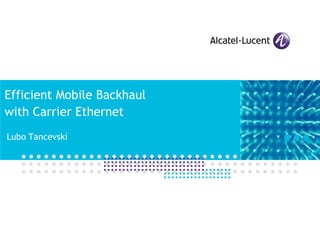The document discusses requirements for efficient mobile backhaul with carrier Ethernet to support LTE networks. It covers:
- LTE network architecture and how it impacts transport network requirements, including the need for multiservice capability, low cost per bit transport, and support for a transition to packet-based networks.
- Key transport network requirements created by LTE like powerful OAM, fast protection switching, strong QoS support, security, and interoperability with the packet core.
- How MPLS-TP can fulfill these requirements through features like VPN support, bearer provisioning across interfaces, coordinated tunnel setup, comprehensive OAM tools, and protection switching capabilities.





![S1-U interface
S11 interface
S1-MME interface
Interconnection between Transport and ePC S5 interface
X2 interface
bearer
MS-PW [Static/T-LDP] PCRF
MPLS-TP IP/MPLS MME
(L2VPN) (L3VPN)
Transport S-GW ePC P-GW
LSP [Static/GMPLS-RSVP-TE] LSP [Static] LSP [RSVP-TE/LDP]
Flattening of the architectures drives similar requirements across the network
VPN support in both Transport and ePC
Bearer concept spans radio, S1 and S5 interface and needs to be
provisioned in both Transport and ePC with similar parameters
Coordination required between S1 and S5 for support of services;
coordinated support for handover
MS-PW for e2e interoperation incl. monitoring and redundancy; Coordinated
tunnel set up
LTE requires stronger coordination between Transport and ePC than 2G/3G
MPLS-TP facilitates coordinated set-up and interoperation
6 | FutureNet 2010| May 2010](https://image.slidesharecdn.com/10fns26-100511102706-phpapp02/85/10-fn-s26-6-320.jpg)













